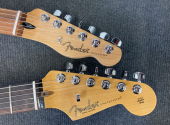
Under the Hood #3: Development of the Fender Esquire (Telecaster)
When one says the Telecaster, most people would immediately think of a yellowish body, a black pickguard and a maple neck. It’s probably the most popular combination on these guitars. Over the years, however, several models have been created that differ not only in color, but also in the varnish, wood or pickups used. Throughout history, several major models have emerged that are still in production. Let me present the very first one, named the Esquire.
In the first part of this series, I described a brief history of the early years of the Telecaster’s development. Now it’s time to take a look at how the guitar evolved in its first two decades, the 1950s and 1960s.
Gradually, Fender came up with new colors and also different wood. The beginnings were not quite easy, because many musicians, as well as Fender developers, were very conservative, and the first guitar color designs, for example, were an object of ridicule. Therefore, it is suitable to start with the Esquire model because its development varied rather in details, and after the first year of experiments it was not such a tough nut to crack for the makers.
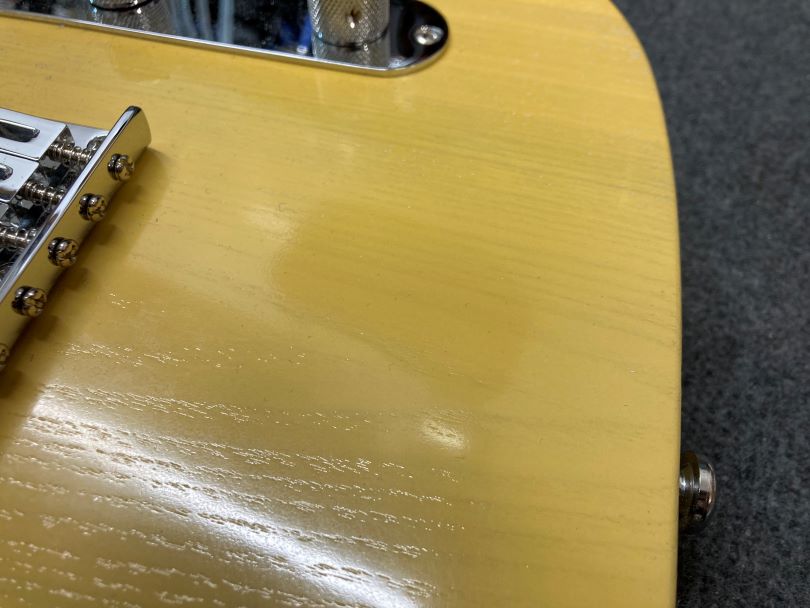
Fender Esquire 1949/1950
Simply put, the Esquire is a Telecaster with one pickup. As a prototype and predecessor to the Telecaster, being simple and with a smaller range of sonic possibilities, the Esquire became more of a complement to it. It was not as popular, and its development was rather marginal. However, its very beginnings were an important breakthrough for Fender because due to it the Telecaster eventually came into existence—making a fundamental change in the guitar world.
Leo Fender worked on the Esquire model as early as in 1949. It officially appeared in the catalogue in the spring of 1950 and saw the light of day as a single bridge pickup model at the June 1950 NAMM Show held in Chicago. In the catalogue display, the body was painted black with a white pickguard, but subsequently the Esquire was produced in yellowish color with a black pickguard. The price of the guitar was $139.95 plus $39.95 for the case. Considering how much these original guitars from the early 1950s cost today, the price has really gone up astronomically.
The first prototype from the turn of ’49/’50 looked a bit different than other better-known versions. There was a cutaway in the body for easier access to higher frets. The tuning pegs were divided into two rows of three on each side of the headstock. The pickguard was black but located on one side of the body only, not extending below the strings. The control panel with two potentiometers was not parallel to the bridge. The body was made of pine wood and painted white. It was slightly thinner (1.5 inches) than the later models (1.75 inches).
After modifying the prototype, Fender finally decided to modify the mechanics by putting the pegs in a single row on one side of the headstock. The result was the iconic head, which is still manufactured in the same design up to the present time.
Compared to the first prototypes, the electronics were gradually modified: the control panel was placed parallel to the bridge and a pickup switch was added. Fender also began making a two-pickup version but eventually the one with a single pickup at the bridge made it into the first production.
The neck was initially wider, but then narrowed to its present dimensions at the zero fret. It was made of one piece of maple, first without reinforcement, then with it.
Nevertheless, after the launch in the summer of 1950, and when the first orders were made, a major setback emerged. The first Esquire models lacked the neck reinforcement and began to warp very soon. Just over fifty of these came out of the factory—and were returned to Fender. The developers had to come up with a quick solution, otherwise the guitars would have ended in failure. So, from October 1950, steel reinforcement began to be installed in the necks to adjust their bending due to to the string tension and prevent them from warping.
The models with neck reinforcement were modified with a second pickup located at the neck and were called the Broadcaster. The Esquire model was discontinued in October 1950 after only three months of production and was not made until January of the following year.
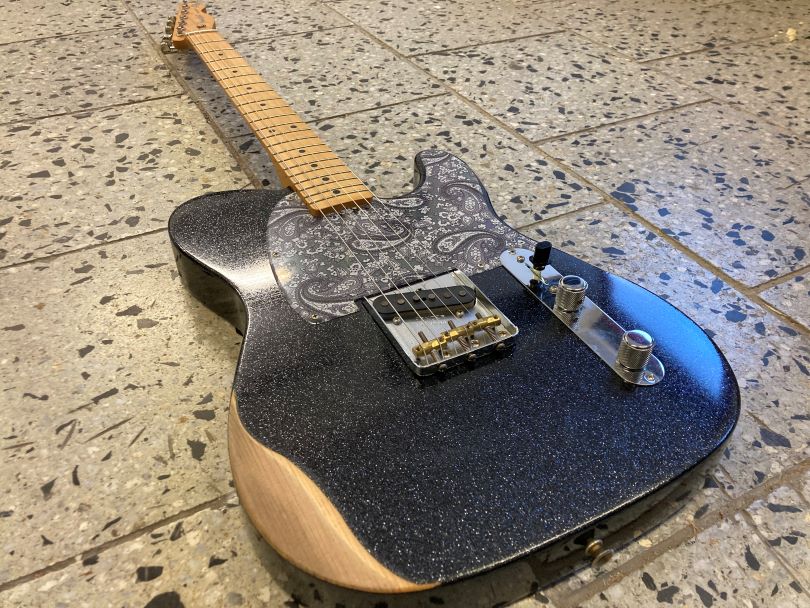
The revival of the Esquire in 1951 led to its production until 1969
Despite the fact that the Broadcaster (a model with two pickups) had been in production for several months, Fender started offering the Esquire again as a single pickup version in January 1951. The two models were pretty much the same. The only difference between them was the number of pickups and the way the electronics were wired.
The Esquire models then differed from year to year, in most cases, in only minor details that corresponded to customer needs or were required due to the manufacturing processes. In the summer of 1950, ash wood instead of pine started to be used for the bodies. Since the Esquire is painted blonde, the body is made entirely of ash, unlike other Fender guitars. Fender proceeded so with all models in blonde finish. In 1950, the bridge and bridge saddles were made of steel, but from 1951 the material was changed to brass. Early models had a butterscotch blonde finish, making them yellowish to the eye. In 1954, the texture of the varnish was slightly changed, and therefore the models were whiter. In 1956, the appearance of the string tree changed from round to butterfly. In the same year, the neck profile changed from a U shape to a soft V, which was replaced by a strong V in the following year. In 1957, the sunburst finish appeared on several models. A rosewood fretboard was used instead of the maple one in 1959.
The last Fender Esquire models left the factory in 1969 and then their production was discontinued. The model was no longer popular. It was seen more as a low-cost option—not offering as many options as the popular Telecaster.
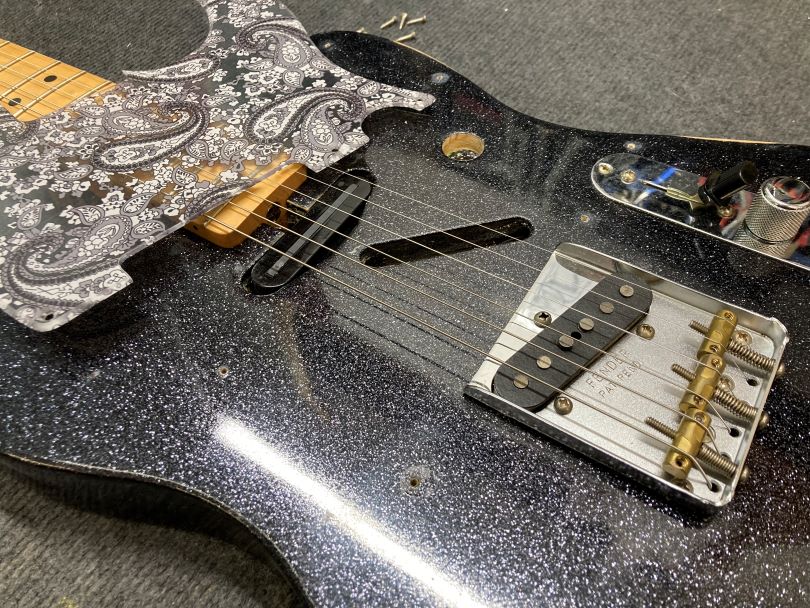
Japanese Esquire and Fender Custom Shop
Esquire models were again produced in 1986 under the Fender Squier brand, which belonged to Fender Japan. They copied the 1954 specifications and were produced in metallic red or the typical butterscotch blonde.
The Fender Custom shop also offers Esquire models. Thanks to traditional manufacturing processes and good materials, they are of high quality. The current range includes, for example, the 1954 Blackguard butterscotch blonde model and the 1950 pine Custom in black with a white pickguard.
Wiring electronics
The Broadcaster had a three-way pickup switch: the neck pickup was connected to the neck position, two pickups together were connected to the middle position, and the bridge pickup was connected to the bridge position. Given the tone pot function, guitarists could choose from a wide range of sound combinations.
The Esquire was equipped with a three-way pickup selector, too. But with ingenious wiring because Fender offered three sound variations of one bridge pickup. The pickup was very similar to the one Leo Fender had developed for his lap steel guitar.
In the bridge position, a simple bridge pickup is plugged in without any modifications. The signal only passes through the volume potentiometer. It therefore offers a powerful output and a characteristic sound full of treble.
In the middle position, the signal passes through both the volume potentiometer and the tone potentiometer. The sound is therefore slightly warmer. This position is sonically the same as the bridge side of the switch on a standard Telecaster.
In the neck position, the signal again goes only through the volume potentiometer, but a capacitor and resistor are connected in the way, which makes the sound more bassy with a reduced output. Leo Fender intended this sound character for guitarists of the 1950s, so that they could easily choose a bassy sound thanks to the switch.
Over the years, the wiring has not changed much. There were variants in using potentiometers of different values, which affected the character of the sound in the intended direction. The characteristics of the switch's neck position were also changed. Capacitors and resistors were given in different values. The popularity of this position was only found by guitarists inclined towards a warm jazz sound.
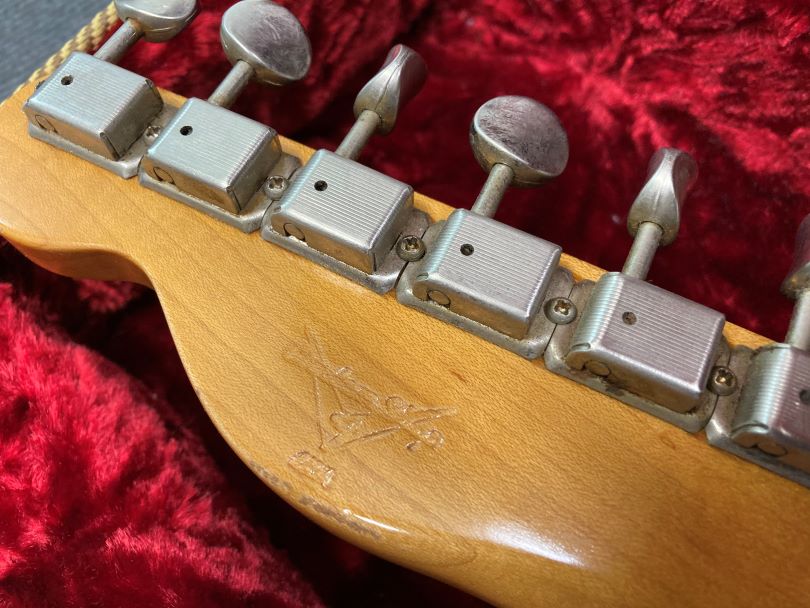
The ideal guitar for tune-ups
The Esquire is perfect not only for those looking for the classic Fender sound, but also for guitarists who want to develop and improve their guitar. Even though this model has only one pickup, there is a neck pickup cavity routed under the pickguard, so one can easily upgrade this guitar with a second pickup.
The electronics are simple, offering a considerable amount of plugging in, whether you have a single or dual-pickup version. Just get inspired by the evolution of wiring and components used that changed the character of sound in the 1950s and 1960s. An interesting modification is the hidden neck pickup under the pickguard on the Brad Paisley model (see photo in the article). The classic look is retained, but the sound is greatly enriched.
Bruce Springsteen, for example, played a heavily modified Esquire. Although he uses replicas on the stage, he would still return to the original guitar when recording. Paul McCartney used a sunburst Esquire with a rosewood fretboard, and he didn’t mind at all that it was a right-handed guitar. He just pulled the strings like a left-handed guitarist and played.
The control panel with potentiometers and pickup switch can be rotated at will and the order of the potentiometers can be changed.
To close
The Fender Esquire is the predecessor of the Telecaster, but over time it was believed that it is a parallel version of this guitar. The bottom line is that it’s an easily modifiable guitar with an unmistakable sound that has become a favorite of many guitarists around the world. The early days of development were far from ideal, but, even so, the Esquire and later the Telecaster have become inherent legends of the guitar world.
If you have found an error or typo in the article, please let us know by e-mail info@insounder.org.


